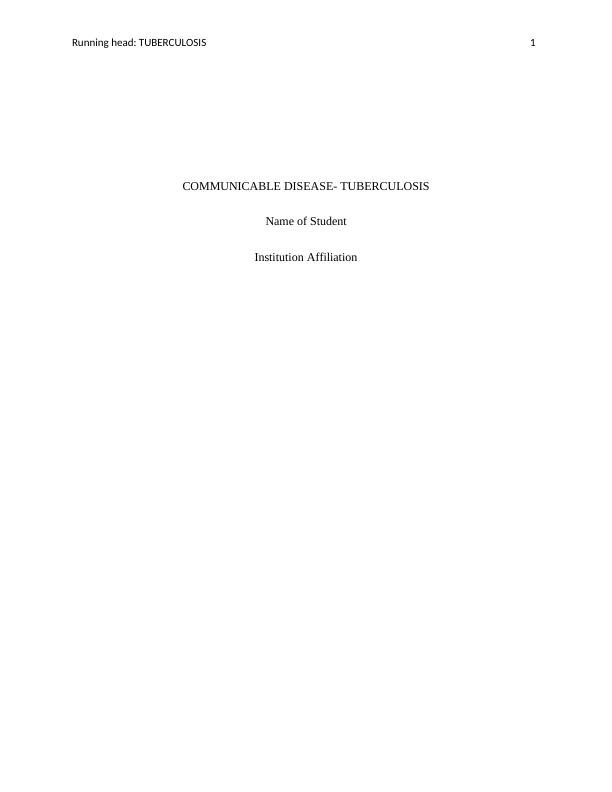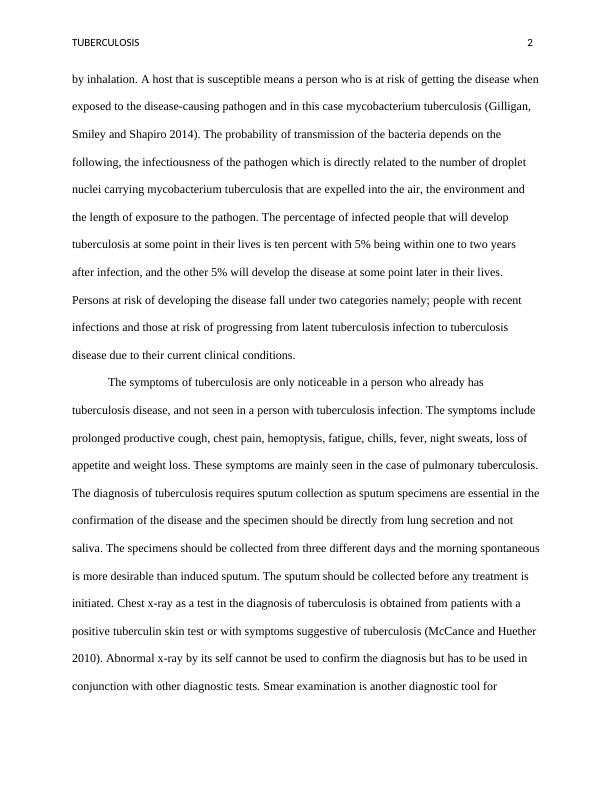Communicable Disease - Tuberculosis
Added on 2023-01-23
8 Pages2254 Words24 Views
Running head: TUBERCULOSIS 1
COMMUNICABLE DISEASE- TUBERCULOSIS
Name of Student
Institution Affiliation
COMMUNICABLE DISEASE- TUBERCULOSIS
Name of Student
Institution Affiliation

TUBERCULOSIS 2
COMMUNICABLE DISEASE- TUBERCULOSIS
A communicable disease is a disease caused by biological agents such as bacteria,
viruses, parasites, and fungi. In addition, or its products and transmitted by the agent or its
products from the host/reservoir to a susceptible host. The transmission can be either directly or
indirectly from man to man, animal to man or environment (air, water or food) to man. A chain
of infection is a model that explains a communicable disease process requires that all the links
involved in a communicable disease must all be present for the infection to occur. These links
include; infectious agent, the portal of exit, reservoir, host that is susceptible, the route of entry,
transmission mode (Mass, 2013). My discussion will talk on tuberculosis as one of the diseases
that are communicable.
Tuberculosis is of the communicable diseases that it is passed via the bacteria
Mycobacterium tuberculosis and spreads from human to human by particles that are airborne and
contain Mycobacterium tuberculosis called droplet nuclei. The transfer of these bacteria takes
place when an infected host sneezes, coughs, sings or laughs and there is a need for prolonged
contact for transmission to take place (Day and Brunner, 2010). Under the model chain of
infection, tuberculosis is spread by Mycobacterium tuberculosis from its host to another
susceptible host. Man serves as the reservoir for the bacteria that resides in the lungs in 85% of
the cases, and there are other sites known as extra pulmonary tuberculosis sites such as urinary
tuberculosis, tuberculous meningitis, genital tract tuberculosis, ocular tuberculosis, and
tuberculosis pericarditis. The portal of exit from man which is the route used by the pathogen to
escape from the reservoir is the respiratory route by way of droplets. The route of transmission
explains how the pathogen Mycobacterium tuberculosis is spread from the reservoir to its new
host is through the respiratory droplets. The portal of entry to its new host is the respiratory route
COMMUNICABLE DISEASE- TUBERCULOSIS
A communicable disease is a disease caused by biological agents such as bacteria,
viruses, parasites, and fungi. In addition, or its products and transmitted by the agent or its
products from the host/reservoir to a susceptible host. The transmission can be either directly or
indirectly from man to man, animal to man or environment (air, water or food) to man. A chain
of infection is a model that explains a communicable disease process requires that all the links
involved in a communicable disease must all be present for the infection to occur. These links
include; infectious agent, the portal of exit, reservoir, host that is susceptible, the route of entry,
transmission mode (Mass, 2013). My discussion will talk on tuberculosis as one of the diseases
that are communicable.
Tuberculosis is of the communicable diseases that it is passed via the bacteria
Mycobacterium tuberculosis and spreads from human to human by particles that are airborne and
contain Mycobacterium tuberculosis called droplet nuclei. The transfer of these bacteria takes
place when an infected host sneezes, coughs, sings or laughs and there is a need for prolonged
contact for transmission to take place (Day and Brunner, 2010). Under the model chain of
infection, tuberculosis is spread by Mycobacterium tuberculosis from its host to another
susceptible host. Man serves as the reservoir for the bacteria that resides in the lungs in 85% of
the cases, and there are other sites known as extra pulmonary tuberculosis sites such as urinary
tuberculosis, tuberculous meningitis, genital tract tuberculosis, ocular tuberculosis, and
tuberculosis pericarditis. The portal of exit from man which is the route used by the pathogen to
escape from the reservoir is the respiratory route by way of droplets. The route of transmission
explains how the pathogen Mycobacterium tuberculosis is spread from the reservoir to its new
host is through the respiratory droplets. The portal of entry to its new host is the respiratory route

TUBERCULOSIS 2
by inhalation. A host that is susceptible means a person who is at risk of getting the disease when
exposed to the disease-causing pathogen and in this case mycobacterium tuberculosis (Gilligan,
Smiley and Shapiro 2014). The probability of transmission of the bacteria depends on the
following, the infectiousness of the pathogen which is directly related to the number of droplet
nuclei carrying mycobacterium tuberculosis that are expelled into the air, the environment and
the length of exposure to the pathogen. The percentage of infected people that will develop
tuberculosis at some point in their lives is ten percent with 5% being within one to two years
after infection, and the other 5% will develop the disease at some point later in their lives.
Persons at risk of developing the disease fall under two categories namely; people with recent
infections and those at risk of progressing from latent tuberculosis infection to tuberculosis
disease due to their current clinical conditions.
The symptoms of tuberculosis are only noticeable in a person who already has
tuberculosis disease, and not seen in a person with tuberculosis infection. The symptoms include
prolonged productive cough, chest pain, hemoptysis, fatigue, chills, fever, night sweats, loss of
appetite and weight loss. These symptoms are mainly seen in the case of pulmonary tuberculosis.
The diagnosis of tuberculosis requires sputum collection as sputum specimens are essential in the
confirmation of the disease and the specimen should be directly from lung secretion and not
saliva. The specimens should be collected from three different days and the morning spontaneous
is more desirable than induced sputum. The sputum should be collected before any treatment is
initiated. Chest x-ray as a test in the diagnosis of tuberculosis is obtained from patients with a
positive tuberculin skin test or with symptoms suggestive of tuberculosis (McCance and Huether
2010). Abnormal x-ray by its self cannot be used to confirm the diagnosis but has to be used in
conjunction with other diagnostic tests. Smear examination is another diagnostic tool for
by inhalation. A host that is susceptible means a person who is at risk of getting the disease when
exposed to the disease-causing pathogen and in this case mycobacterium tuberculosis (Gilligan,
Smiley and Shapiro 2014). The probability of transmission of the bacteria depends on the
following, the infectiousness of the pathogen which is directly related to the number of droplet
nuclei carrying mycobacterium tuberculosis that are expelled into the air, the environment and
the length of exposure to the pathogen. The percentage of infected people that will develop
tuberculosis at some point in their lives is ten percent with 5% being within one to two years
after infection, and the other 5% will develop the disease at some point later in their lives.
Persons at risk of developing the disease fall under two categories namely; people with recent
infections and those at risk of progressing from latent tuberculosis infection to tuberculosis
disease due to their current clinical conditions.
The symptoms of tuberculosis are only noticeable in a person who already has
tuberculosis disease, and not seen in a person with tuberculosis infection. The symptoms include
prolonged productive cough, chest pain, hemoptysis, fatigue, chills, fever, night sweats, loss of
appetite and weight loss. These symptoms are mainly seen in the case of pulmonary tuberculosis.
The diagnosis of tuberculosis requires sputum collection as sputum specimens are essential in the
confirmation of the disease and the specimen should be directly from lung secretion and not
saliva. The specimens should be collected from three different days and the morning spontaneous
is more desirable than induced sputum. The sputum should be collected before any treatment is
initiated. Chest x-ray as a test in the diagnosis of tuberculosis is obtained from patients with a
positive tuberculin skin test or with symptoms suggestive of tuberculosis (McCance and Huether
2010). Abnormal x-ray by its self cannot be used to confirm the diagnosis but has to be used in
conjunction with other diagnostic tests. Smear examination is another diagnostic tool for

End of preview
Want to access all the pages? Upload your documents or become a member.
Related Documents
Chain of Infection and Mode of Transmission for Tuberculosislg...
|6
|2238
|60
Understanding Chain of Infection and Modes of Transmission in Workplacelg...
|1
|1926
|494
Preventing Infection and Control in Nursinglg...
|6
|1162
|293
Tuberculosis: Causes, Symptoms, and Treatmentlg...
|8
|1669
|483
Causal Organism of Tuberculosislg...
|5
|1112
|64
Infection Control in Healthcare: Risks, Controls, and Procedureslg...
|10
|2285
|479
